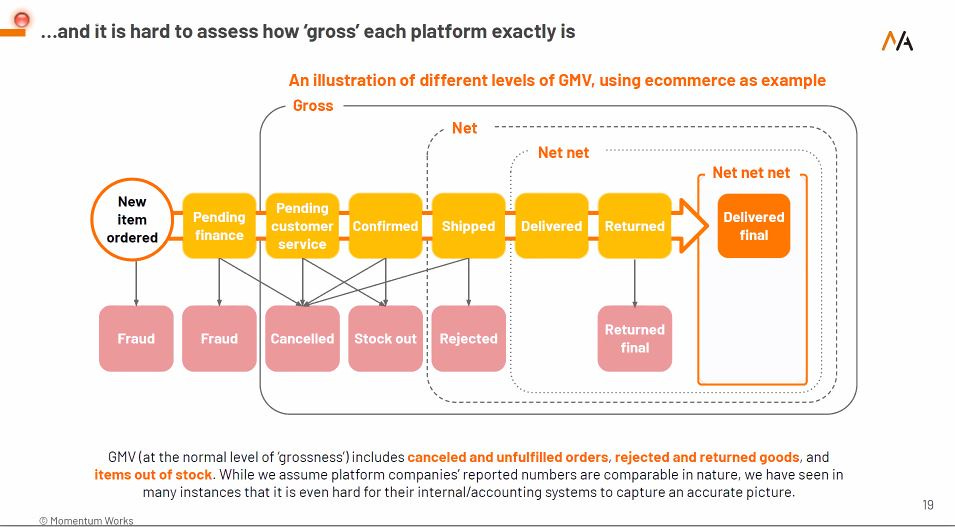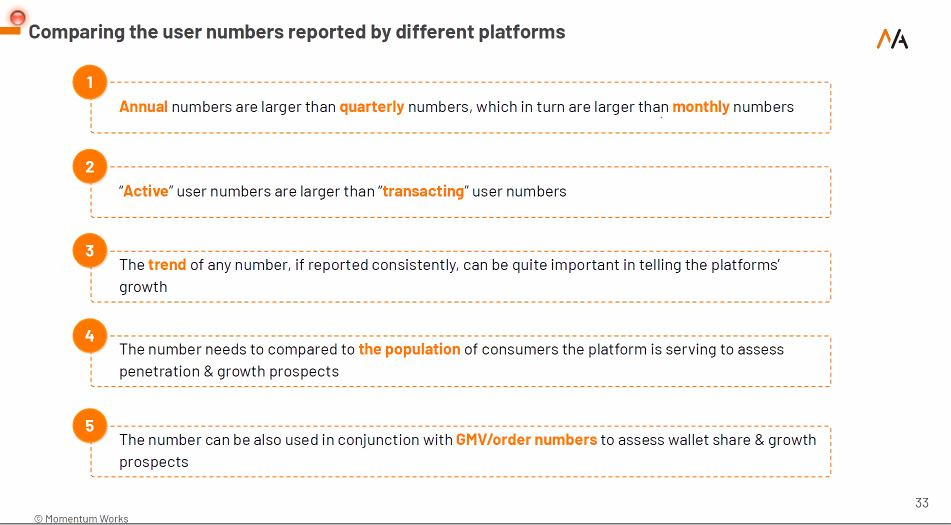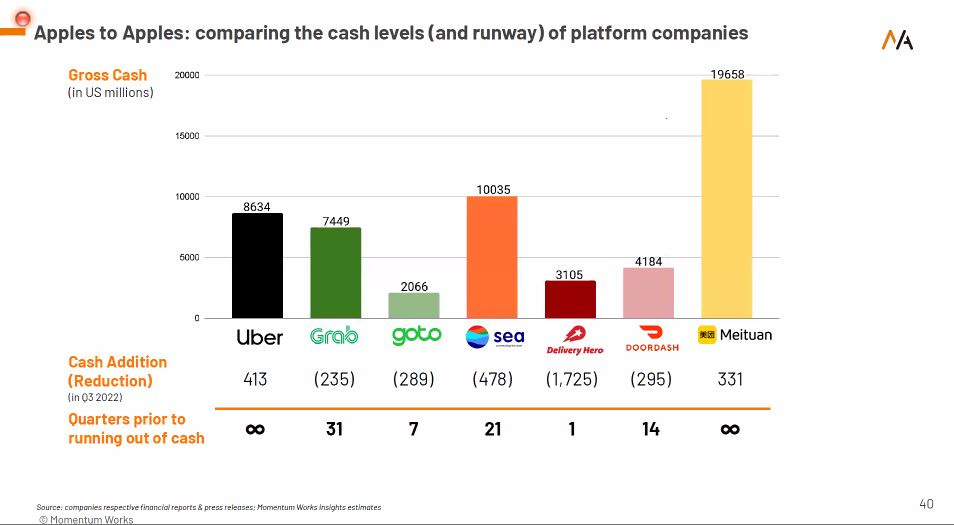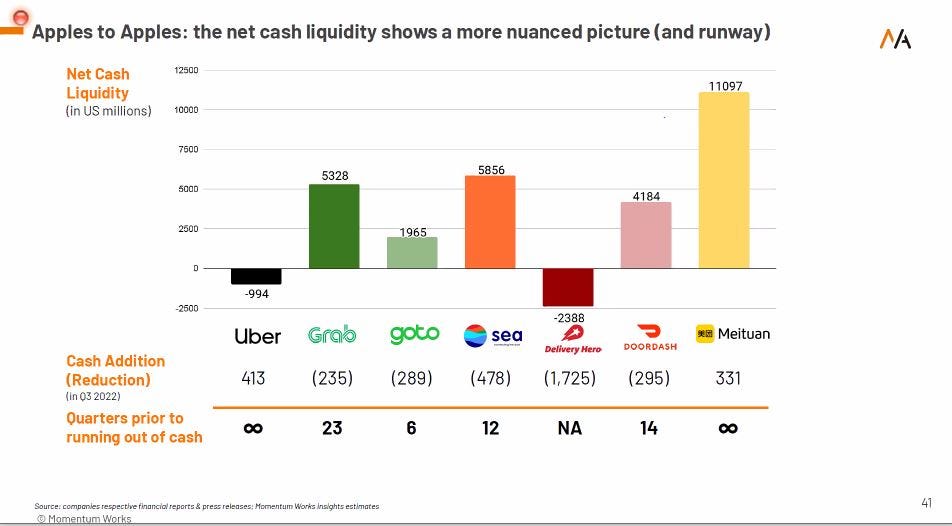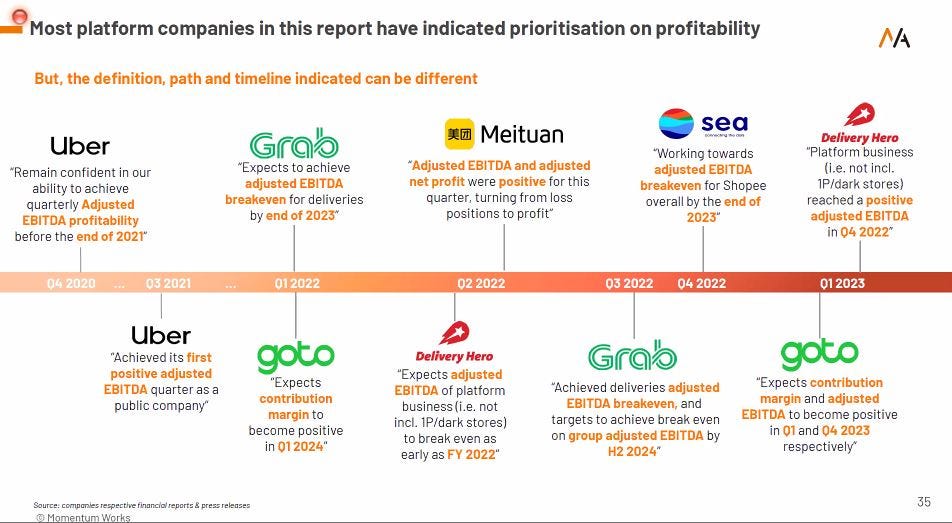Making Sense of Delivery Platform Stock Metrics and Financials
Delivery platform stocks Grab, GoTo, Sea Group, DeliveryHero, Uber, DoorDash, Pinduoduo & Meituan use different financial and reporting metrics - making it hard for investors to make sense of them.
Earlier today Asia time, Singapore based Momentum Works had their one hour Apples to Apples: Benchmarking Shopee, Grab, GoTo and other major tech platforms webinar (the page for the accompanied written report is here where you can see some key slides from it) to try and make sense of the varied financial and other reporting metrics for delivery platform stocks such as Grab, GoTo, Sea Group, DeliveryHero, Uber, DoorDash, Pinduoduo, and Meituan.
In case you are not familiar with some of these delivery platform stocks:
Grab - Singapore based and NASDAQ listed Grab Holdings Limited (NASDAQ: GRAB) is a leading superapp in Southeast Asia, providing everyday services such as mobility, deliveries, and digital financial services to millions of Southeast Asians.
GoTo - Jakarta listed PT GoTo Gojek Tokopedia Tbk (IDX: GOTO.JK) is the largest digital ecosystem in Indonesia comprising of on-demand transport, eCommerce, food and grocery delivery, logistics and fulfilment, and financial services through the Gojek, Tokopedia, and GoTo Financial platforms.
Sea - Singapore based and NYSE listed Sea Limited (NYSE: SE) has three core businesses:
DeliveryHero - Germany based and Frankfurt listed Delivery Hero SE (FWB: DHER) is present in 70 countries across four continents delivering anything - from food to quick commerce.
Uber - USA based and NYSE listed Uber Technologies, Inc (NYSE: UBER) provides mobility as a service/ride-hailing, food delivery/package delivery/couriers via Uber Eats and Postmates, and freight transport.
DoorDash - USA based and NYSE listed DoorDash, Inc (NYSE: DASH) connects consumers with their favourite local businesses in 27 countries.
Pinduoduo - China based and Nasdaq listed PDD Holdings (NASDAQ: PDD) is the multinational commerce group that owns and operates a portfolio of businesses, including Pinduoduo (started as a fresh agriculture platform before expanding to a leading social commerce player serving approximately 900 million users) and Temu (an e-commerce marketplace in North America allowing Chinese vendors to sell their products directly to US consumers).
Meituan - China based and Hong Kong listed Meituan (SEHK: 3690) is a shopping platform for locally found consumer products and retail services, including entertainment, dining, delivery, travel, and other services (also see Case study series – Meituan: Finding business clarity from Momentum Works)
Momentum Works did provide a link to the presentation they gave during the webinar (which I am not sure if I can share - you should contact them directly IF interested) plus they have many other interesting reports here (focused on tech investments in SE Asia).
The structure for this post will be as follows:
Just How Complicated Are Delivery Platform Metrics?
How Many Users Are There and What Exactly is Cash?
Some Profitability Timeframes…
Some Observations:
Bad Delivery Rider Practices (And Risk Implications)…
Too Many Toxic Customers…
Vertical Integration by Buying Brick-and-Mortar Supermarket Chains and Building Dark Stores and Cloud Kitchens…
HappyFresh’s Struggles
Conclusions
Just How Complicated Are Delivery Platform Metrics?
I screenshotted a couple of slides during the webinar to give you an idea of just how complicated the topic of financial or reporting metrics are for these types of delivery platform stocks or companies:
This slide in particular is worth nothing as the delivery platforms mentioned had listings on various stock exchanges (e.g. USA, Singapore, Indonesia etc) which will also impact how they report financials and other key metrics:
How Many Users Are There and What Exactly is Cash?
Even the reporting of user numbers and what constitutes users will vary from platform to platform:
And then there is the topic of cash and what is considered to be cash:
If net cash is cash minus liabilities, then what is considered to be liabilities?
For example: Momentum Works observed how many of these delivery platform stocks have convertible loans on their balance sheets with a conversion price. Converting to shares rather than cash would not cause a cash outflow from the company (but it will obviously be bad for existing shareholders and limit stock appreciation…)
Some Profitability Timeframes…
For investors though, this slide will be important, but again there is probably no agreement or consistencies on the underlying numbers or how they are calculated:
Some Personal Observations:
Bad Delivery Rider Practices (And Risk Implications)…
During the pandemic and lockdowns, there was one food delivery player in Kuala Lumpur who’s riders were consistently reckless. I could stand at a major KLCC intersection near the Petronas Towers and watch at least one or two of their motorcycle riders run red lights (as in cross the intersection and make a turn). Delivery riders from other delivery platforms would not do this (then again, they may not have been delivering someone’s lunch or dinner…).
Obviously, the drivers from this particular delivery platform were either poorly paid, there were bad incentives in place that encouraged reckless driving, or maybe they were just practicing their “Mat Rempit” racing skills for the next weekend out on Kuala Lumpur’s Federal Highway!
Either way, I was waiting for a gory accident to occur e.g. a pedestrian (hopefully not me!) loosing a leg or a bad accident with multiple fatalities as that would (hopefully…) trigger a government crackdown or lawsuits and stop reckless delivery rider practices.
And while I have yet to ever use a food delivery service, there is literally NO WAY I would ever use this particular delivery service due to observing their riders. Having a working class person risk their life to deliver me a meal is not ethically appealing - and frankly not convenient for me. For example: Restaurant meal delivery is a hassle when living in a high rise condo with security, multiple towers/entrances that confuse visitors, not knowing for sure when a rider will show up, and when there were COVID pandemic restrictions in place on who could enter the complex (And besides, I strictly pay in cash for meals…)
When I asked in the Q&A for any comments on rider pay and incentives with the various delivery platforms, someone from Momentum Works answered by saying it was an extremely complex topic to discuss as it also varied by company and location.
Either way, I do see it as a potential risk - both reputational and regulatory - for such platforms IF they are encouraging their delivery riders to act like Mat Rempit participants.
Too Many Toxic Customers…
During the lockdowns in SE Asia, many working class people lost their jobs and were forced to become delivery riders until restaurants and other businesses could reopen and rehire them.
I had seen comments posted on Facebook from delivery riders about how a certain percentage of delivery customers were ABSOLUTELY TOXIC as in they would complain ABOUT EVERYTHING and give bad reviews no matter what. And it was not a small percentage either - it was something like 1 or 2 (or more…) out of every 100 customers.
If 1 or 2 out of every 100 customers is a toxic customer and the rider is doing 100+ deliveries a week (probably much more when it comes to meal deliveries), it may impact their performance reviews and any incentive pay (hence, the reckless riding I had observed…). And many delivery riders apparently could not wait to quit and go back to regular jobs once normal businesses were allowed to reopen again.
In addition, restaurants were getting fed up with toxic customers complaining about cold or spoiled food and leaving bad reviews.
Since restaurants cannot control quality when third party delivery apps and delivery services are used, they could not wait to just stop or limit food deliveries or the use of third party services for it once things returned to normal.
Vertical Integration by Buying Brick-and-Mortar Supermarket Chains and Building Dark Stores and Cloud Kitchens…
Thus, the delivery platform companies have been forced to move up the vertical or supply chain or take on more functions.
With that in mind, this slide from the webinar caught my attention:
Someone I had talked to last year who had left one of the food delivery platforms in Thailand had told me during the pandemic/lockdowns or the aftermath, their delivery business took a big hit because:
The big poultry farms or processors in Thailand did not have enough workers (either they went home to the provinces or maybe they had been guest workers from Myanmar who had returned home or were not allowed to re-enter Thailand).
This led to big chicken shortages for Bangkok restaurants.
Chicken is a major source of cheap protein and often the main dish or ingredient for restaurant meals.
Without chicken supplies, restaurants could not do much business.
No chicken and no business for restaurants meant no delivery business for food delivery platforms.
Thus, I was told the food delivery platform was forced to get into the chicken sourcing business in order to help their restaurants customers get chicken supplies so they could then deliver meals on their behalf.
Whereas in the past, brick-and-mortar businesses got into online (e.g. eCommerce sites, delivery etc), delivery platforms have been forced to do the reverse by buying traditional brick-and-mortar businesses like supermarkets:
And even if they are not buying entire supermarket chains, delivery platforms have had to set up their own networks of “dark stores” or DCs/warehouses:
And they are also setting up cloud kitchens (effectively competing with their restaurant customers…) as food preparation is more profitability than just doing food delivery:
As you can imagine, setting up or acquiring and then managing all of this “brick-and-mortar” will burn through considerable amounts of cash.
HappyFresh’s Struggles
In a high inflationary and high interest rate environment, only the biggest cash rich delivery players (or those with access to limitless funding) will be able to survive.
The Momentum Works webinar never mentioned online grocery platform HappyFresh - a medium sized SE Asia player with a good reputation for doing fresh products (a very difficult business to do correctly but they apparently do it well). Late last year, they had to suspend operations in both Malaysia and Thailand (after pulling out of Taiwan and the Philippines some years ago) as venture capital funding dried up:
A timeline of HappyFresh’s tumultuous 7-year journey in M’sia, from launch to closure
HappyFresh resumes Indonesia grocery deliveries after new funding
HappyFresh Malaysia’s own warehouses are its latest strategy toward a path of profitability
Conclusions
I had heard some of HappyFresh’s daily order volume or delivery numbers for Malaysia and Thailand along with the values of those orders. Based on what I was told, it is hard for me to be overly impressed with delivery platform businesses - as in, why not just stick with doing a traditional brick-and-mortar business that also dabbles online and does some delivery?
In the past, delivery platform stocks might have saved on things like retail real estate and food service equipment or storage (e.g. refrigerators, freezers, cold storage, etc.) costs, but they probably needed to spend considerably more on human capital (as in higher salaries for the types of staff and managers needed for the complicity of such businesses), marketing (including online), and IT.
But some of these delivery platforms are now buying brick-and-mortar supermarket chains, building cloud kitchens, managing dark store networks, etc. Unless taking a delivery platform and going into or setting up more traditional brick-and-mortar businesses or operations ultimately achieves higher profit margins, it’s hard to see how the numbers will ultimately work out for profitability - especially in an inflationary and high interest rate environment where costs are rising.
Likewise and even after watching the webinar, these sorts of delivery platform stocks or rather their financials or metrics remain too complicated for me to effectively understand (with the potential for them to be “gamed”) or want to invest in. The Momentum Works webinar and report does not change my view, but are well worth looking at IF you are invested in such stocks.
Check out our emerging market ETF lists, ADR lists (updated) and closed-end fund (updated) lists (also see our site map + list update status as some ETF lists are still being updated as of Summer 2022).
I have changed the front page of www.emergingmarketskeptic.com to mainly consist of links to other emerging market newspapers, investment firms, newsletters, blogs, podcasts and other helpful emerging market investing resources. The top menu includes links to other resources as well as a link to a general EM investing tips / advice feed e.g. links to specific and useful articles for EM investors.
Disclaimer. The information and views contained on this website and newsletter is provided for informational purposes only and does not constitute investment advice and/or a recommendation. Your use of any content is entirely at your own risk and it is your sole responsibility to evaluate the accuracy, completeness and usefulness of the content. Seek a duly licensed professional for any investment advice. I may have positions in the investments covered. This is not a recommendation to buy or sell any investment mentioned.
Making Sense of Delivery Platform Stock Metrics and Financials was also published on our website under the Newsletter & EMS Analysis categories.








